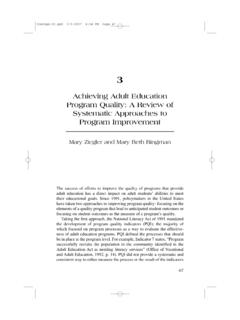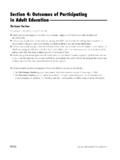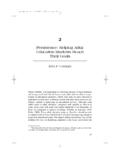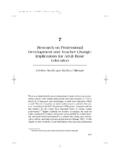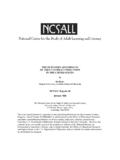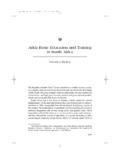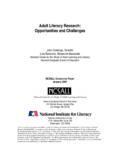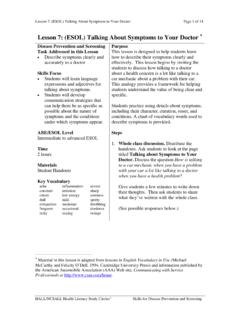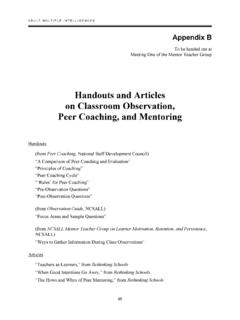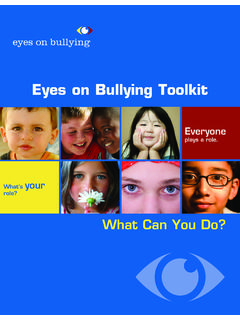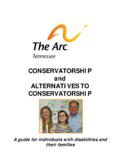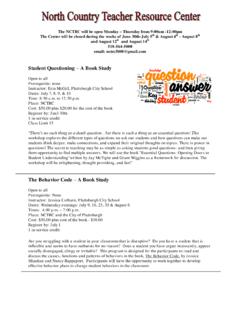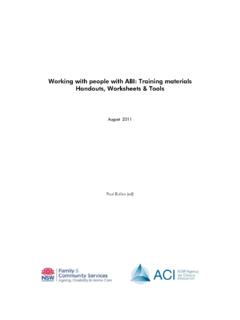Transcription of The Changing Landscape of Adult Learning Theory
1 6 The Changing Landscapeof Adult Learning TheorySharan B. MerriamSince the founding of the field of Adult education, the task of explaininghow Adult learners learn has been a major one on the part of bothresearchers and practitioners. Adult Learning , after all, is the glue thatholds together an otherwise widely disparate field, a field that ranges fromadult basic education (ABE) to human resource development, and fromeducational gerontology to continuing professional education. The varietyof settings in which Adult education occurs, the range of curricula, and thediversity of the students have caused the field to be a sprawling somewould say incoherent entity, united in the one common goal of facilitat-ing Adult Learning .
2 After some 80 years of study, we have no single answer,no one Theory or model of Adult Learning . What we have instead is a color-ful mosaic of theories, models, sets of principles, and explanations thatcombined create the knowledge base of Adult Learning . At the center ofthese theories and models is the Adult engaging in formal and informallearning activities that address some perceived need or interest. Whetherenrolled in an ABE class, participating in a management training session atwork, or Learning to trace his or her family history, the Adult is engaged inlearning. The more we know about the identity of the learner, the contextof this Learning , and the Learning process itself, the better able we are todesign effective Learning development of this knowledge base can be divided into threeperiods.
3 Early research on Adult Learning focused on answering the ques-tion of whether adults could learn. By midcentury, Adult educators be-came concerned with the question of how Adult Learning could be differ-entiated from the way in which children learn. Finally, since the mid-1980s, Adult Learning Theory has expanded to incorporate several newapproaches from disciplines outside the field of Adult education. The con-tributions of each of these periods make up the current Landscape of adultlearning : CAN adults LEARN?From anecdotal evidence, philosophical musings, and storied narratives,we have known for centuries that adults learn as part of their daily , human Learning was not studied systematically by behavioralscientists in controlled settings until the early decades of the 20th , perhaps because Learning had by then become associated withschooling, the assumption that adults could learn became something to bequestioned, tested, and documented.
4 In Adult Learning (Thorndike, Breg-man, Tilton, & Woodyard, 1928), the first book to report the results ofresearch on this topic, the authors claimed that teachers of adults of age25 to 45 should expect them to learn at nearly the same rate (p. 178) as20-year-olds. Thorndike and others approached Adult Learning from abehavioral psychological perspective, testing learners of all ages undertimed conditions on various Learning and memory much of this early research pitted older adults against youngpeople under timed conditions, it appeared that as one aged, the ability tolearn declined. It was later pointed out that Adult test scores were relatedto previous education and skills, not to age per se, and that when timepressure was removed, adults up to age 70 did as well as younger adults (Lorge, 1944, 1947).
5 Intelligence testing was another major focus of this early research. Aswith Learning tasks, older adults did not score as well as younger adults ,who in turn did not do as well as young students. The introduction of moresophisticated research designs combined with multifactor models of intel-ligence challenged the notion that intelligence necessarily declined withage. Rather, it appeared that some aspects of intelligence declined withage, whereas others increased, resulting in a fairly stable composite mea-200 MERRIAM sure of intelligence throughout adulthood (Schaie & Willis, 1986). Schaie(1996) noted that the way intelligence has been studied involves a naturalhierarchy.
6 Leading from information processing, through the productsmeasured in tests of intelligence, to practical and everyday intelligence (p. 266). Currently, multifactor models are thought to present a more accu-rate picture of intelligence. The most prominent are Cattell s (1963) theoryof fluid and crystallized intelligence, Guilford s (1967) structure of intel-lect, Gardner s (1993) Theory of multiple intelligences, and Sternberg s(1996) work on practical aspects of human Learning , such as problem solving, informationprocessing, and memory, have engaged educational psychologists, geron-tologists, and cognitive psychologists since the early decades of the 20thcentury.
7 If adults are included in this research, investigators tend to framethe research in terms of how advancing age affects the Learning activity(Bee, 2000). Because much of this research has been conducted in labora-tories and other artificial settings, it is difficult to make generalizationsfrom it or to apply it to real-life situations. Furthermore, deficits anddeclines are often shown to be functions of noncognitive factors, such aslevel of education, training, health, and speed of response (Merriam &Caffarella, 1999).Another stream of research begun in the early decades of the 20th cen-tury that continues to this day has focused less on whether adults couldlearn and more on the Learning process itself.
8 Specifically, cognitive devel-opment that is, how one s cognitive structure changes with age wasinvestigated first by Piaget. Piaget s (1966) stages of cognitive develop-ment became the foundation for other models, some of which deal moreexplicitly with adults . Perry (1981), for example, working with data onyoung Adult college students, proposed nine positions (rather than stages)of development that move from relatively simple thinking patterns tohighly complex ways of perceiving and evaluating knowledge. Drawingfrom Perry and others, Belenky, Clinchy, Goldberger, and Tarule (1986)grouped women s ways of knowing into five major categories, rangingfrom silence, in which women are passive, mindless, and voiceless, to con-structed knowledge, in which women view knowledge as contextual andthemselves as creators of knowledge, thus having both a mind and (1994) argued that our thinking must continue to evolve throughfive levels of consciousness to navigate the mental demands of modernlife.
9 Proponents of yet another model suggest that mature thought is adialectic process entailing the ability to accept inherent contradictions andambiguities (Basseches, 1984; Riegel, 1973). Finally, Sternberg (1990), Landscape OF Learning THEORY201among others, posited that wisdom, though culturally and contextuallybound, is the epitome of cognitive in the foundational work on intelligence, information process-ing, memory, and cognitive development was the question of whetheradults could learn. And, depending on how Learning was measured, it wasdiscovered that they could learn as well as young people. Most of theresearch on these topics was and still is behaviorist in design, oftenplacing adults in the same test conditions as children.
10 More recently, how-ever, these same topics have been investigated from a perspective thattakes the Adult s life situation, life experiences, and social and culturalinfluences into consideration. Even the investigation of wisdom, consid-ered by many to be the pinnacle of cognitive development and the cul-mination of a lifetime of Learning , is being studied from a socioculturalperspective (Sternberg, 1990).THE DEVELOPMENT OF ADULTLEARNING THEORYU ntil about the 1950s, Adult educators relied on research in psychologyand educational psychology for an understanding of Adult Learning . But aspart of the drive to professionalize the field, Adult educators recognized theneed to have their own unique knowledge base.
